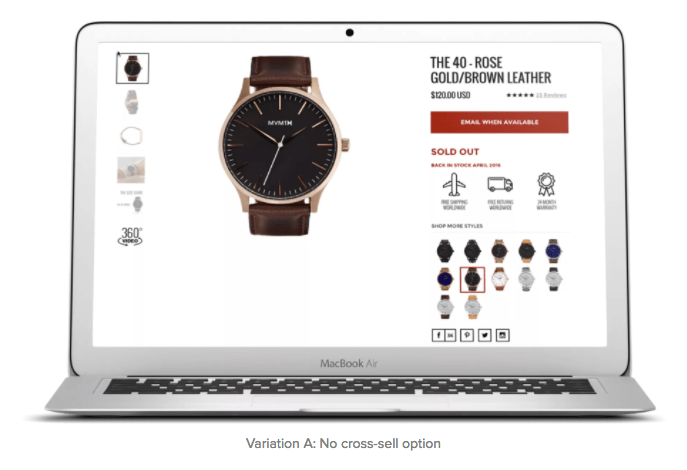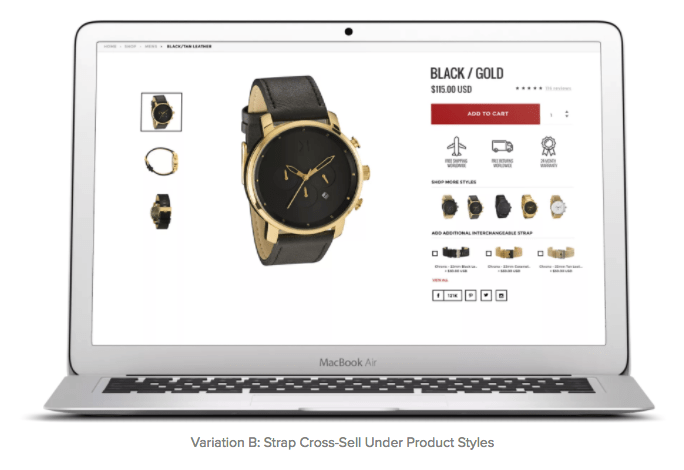Cross-Selling With MVMT Watches

When MVMT Watches was founded in 2013, the team knew right away that optimization would be key to the company’s success. If a Shopify store has the ability to evolve and innovate faster than their competitors, it ensures that every decision they make (and invests) has a positive impact on revenue.
Customer retention and customer life time value are major focuses for MVMT because of the nature of watches: customers are only in the market for a watch once every few years. So, how does MVMT increase the average order value of each customer purchase? By cross-selling.

MVMT decided they wanted to increase the average order value of each customer by adding in interchangeable straps to every product pages of their existing core offering of watches. What were the results? Adding this new cross-sell item increased conversions by 5.5% for mobile shoppers and 2.2% for desktop shoppers. How did they implement it?
Choosing Where To Promote A New Cross-Sell Product
MVMT first needed to do a deep analysis to determine the optimal part of the buying process to promote the cross-sell.
They considered three different scenarios for promoting the straps:
– Promote in the shopping cart
– Promote right after purchase on the confirmation page
– Promote on the product page
Weighing the pros and cons of each, promoting the cross-sell item on the product page most closely reflected the in-person buying experience for a watch and therefore would be the best but feared the straps might be a distraction. MVMT then started testing the straps on the product page to understand the impact on revenue and conversions. They then approached design for the desktop and mobile pages separately, testing each context uniquely.
The Desktop Customer Experience
On desktop, they hypothesized placing the straps next to the watch would fit naturally into the buying process and increase revenue per visitor without significantly decreasing total completed sales. They tested placement of the strap promotion with three variations:



Variation B with the strap cross-sell below the area of the page that gives the guest a choice of product style produced a 2.2% increase in revenue and an increase in average order value.
They hypothesize that this version performed better on desktop because it is a more natural shopping experience to choose a watch first and then browse strap options.
While the conversion rate, or the number of completed sales, did decline slightly with this test, approximately .4%, the increase in average order value and therefore revenue per visitor more than makes up for the slight decrease in sales. The significant revenue increase can be attributed to an increase in order value from the addition of straps to each purchase.
The Mobile Experience
Given that 55% of MVMT’s site traffic comes from mobile, the team needed to dig deeper into their data to make sure the test was uniquely optimized for mobile and not simply a transfer of the winning desktop experience.
To start they looked at mobile scroll mapping to understand what percentage of shoppers would scroll deep enough down the page to see the straps if they were displayed beneath the “product styles” section as they were on the desktop site. They found that only 8% of guests would have ever made it to the interchangeable strap section. Armed with this information, they designed an experience that would perform better for mobile visitors.

Placing the strap cross-sell directly beneath the “add to cart” button performed with a 5.5% increase in revenue and increase in conversions on mobile for this variation of about 1.6%.
The strap upsell directly below the product image is performing better on mobile for revenue because the strap upsell is directly below the product presentation. The version with strap upsell at the bottom is not as effective because most people on mobile will never make it far enough down the page to interact with the straps.
Conclusion
MVMT gained a ton of insight from this cross-sell test. Here’s a summary of the top lessons learned:
1. Know your audience – Knowing that MVMT watches has a more mobile than desktop traffic, they tailored this test to reflect the needs of mobile guests, which generated big gains.
2. Mimic “in store” experience to create integrated buying experience – Doing this helped them to integrate the strap cross-sell option seamlessly into the buying process without making it look “tacked-on” like you might find with something like a “you may also like” section on the product page or shopping cart.
3. Test introducing new or cross-sell products to prove impact – It is valuable to test merchandising on newly introduced products to the site, cross-sell or otherwise. This test proves that with a 5.5% increase in conversion from product pages on mobile and a 2.2% increase in revenue on desktop.
